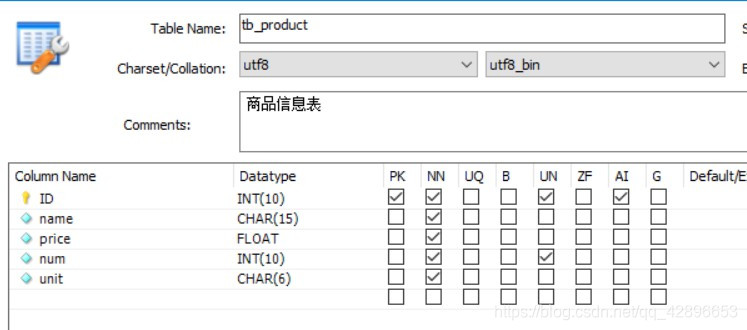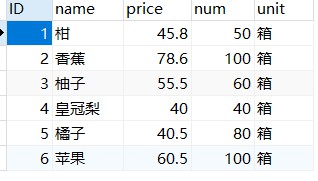JavaWeb——操作数据库之JDBC分页查询
其他
2020-02-08 18:30:30
阅读次数: 0
JavaWeb——JDBC操作数据库
八、分页查询
- 当数据库中数据量非常大时,将所有数据都存放在一个页面显然是不合适的,因此有必要进行分页查询,将数据按顺序分为几个页面来显示。
- 实现方法由两种,一种是通过 Resultset 的光标进行分页,优点是数据库通用,缺点是占用资源非常大;另外一种是通过数据库机制进行分页,本博文也是采用此种方法,针对 MySQL 数据库的语法,使用 limit 关键字,做到分页查询。
1、数据表准备
3、编写 Bean
- 需要准备两个 Bean,代码分别如下:
- Bean 1
public class Product {
public static final int PAGE_SIZE = 2;
private int id;
private String name;
private double price;
private int num;
private String unit;
public int getId() {
return id;
}
public void setId(int id) {
this.id = id;
}
public String getName() {
return name;
}
public void setName(String name) {
this.name = name;
}
public double getPrice() {
return price;
}
public void setPrice(double price) {
this.price = price;
}
public int getNum() {
return num;
}
public void setNum(int num) {
this.num = num;
}
public String getUnit() {
return unit;
}
public void setUnit(String unit) {
this.unit = unit;
}
}
- Bean 2
import java.sql.*;
import java.util.ArrayList;
import java.util.List;
public class ProductDao {
public Connection getConnection(){
Connection conn;
try{
Class.forName("com.mysql.jdbc.Driver");
String url = "jdbc:mysql://localhost:3306/test?serverTimezone=GMT%2B8";
String username = "root";
String password = "********";
try{
conn = DriverManager.getConnection(url, username, password);
if(conn != null)
{
return conn;
}
}catch (SQLException e){
e.printStackTrace();
}
}catch (ClassNotFoundException e){
e.printStackTrace();
}
return null;
}
public List<Product> find(int page){
List<Product> list = new ArrayList<>();
Connection conn = getConnection();
String sql = "select * from tb_product order by id desc limit ?,?";
try{
PreparedStatement ps = conn.prepareStatement(sql);
ps.setInt(1, (page-1)*Product.PAGE_SIZE);
ps.setInt(2, Product.PAGE_SIZE);
ResultSet rs = ps.executeQuery();
while(rs.next()){
Product p = new Product();
p.setId(rs.getInt("id"));
p.setName(rs.getString("name"));
p.setPrice(rs.getDouble("price"));
p.setNum(rs.getInt("num"));
p.setUnit(rs.getString("unit"));
list.add(p);
}
rs.close();
ps.close();
conn.close();
} catch (SQLException e){
e.printStackTrace();
}
return list;
}
public int findCount(){
int count = 0;
Connection conn = getConnection();
String sql = "select count(*) from tb_product";
try{
Statement stmt = conn.createStatement();
ResultSet rs = stmt.executeQuery(sql);
if(rs.next()){
count = rs.getInt(1);
}
rs.close();
stmt.close();
conn.close();
} catch (SQLException e){
e.printStackTrace();
}
return count;
}
}
3、JSP 页面准备
4、Servlet 创建
- 创建一个 Servlet 用于处理请求,代码如下:
import com.lyq.bean.Product;
import com.lyq.bean.ProductDao;
import javax.servlet.ServletException;
import javax.servlet.annotation.WebServlet;
import javax.servlet.http.HttpServlet;
import javax.servlet.http.HttpServletRequest;
import javax.servlet.http.HttpServletResponse;
import java.io.IOException;
import java.util.List;
@WebServlet(name = "FindProductServlet", urlPatterns = "/FindProductServlet")
public class FindProductServlet extends HttpServlet {
protected void doPost(HttpServletRequest request, HttpServletResponse response) throws ServletException, IOException {
}
protected void doGet(HttpServletRequest request, HttpServletResponse response) throws ServletException, IOException {
int currPage = 1;
if(request.getParameter("page") != null){
currPage = Integer.parseInt(request.getParameter("page"));
}
ProductDao dao = new ProductDao();
List<Product> list = dao.find(currPage);
request.setAttribute("list", list);
int pages;
int count = dao.findCount();
if(count % Product.PAGE_SIZE == 0){
pages = count/Product.PAGE_SIZE;
}else{
pages = count/Product.PAGE_SIZE + 1;
}
StringBuffer sb = new StringBuffer();
for(int i=1; i<=pages; i++){
if(i == currPage){
sb.append("『").append(i).append("』");
}else{
sb.append("<a href=FindProductServlet?page=").append(i).append(">").append(i).append("</a>");
}
sb.append(" ");
}
request.setAttribute("bar", sb.toString());
request.getRequestDispatcher("/JDBCOption/Product_list.jsp").forward(request, response);
}
}
5、调试运行
上一篇
下一篇
发布了146 篇原创文章 ·
获赞 15 ·
访问量 1万+
转载自blog.csdn.net/qq_42896653/article/details/103389785




